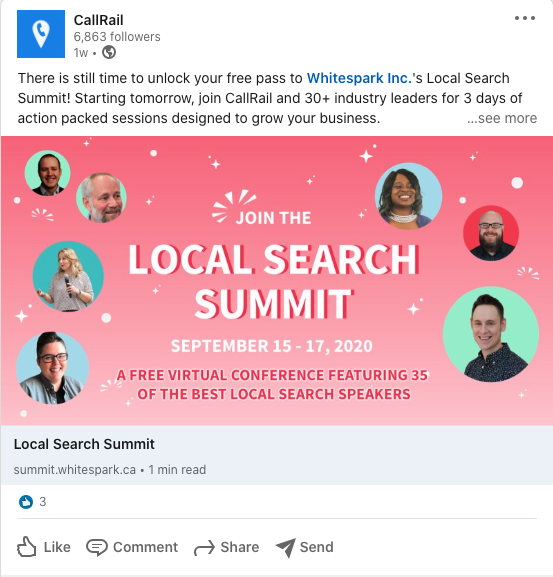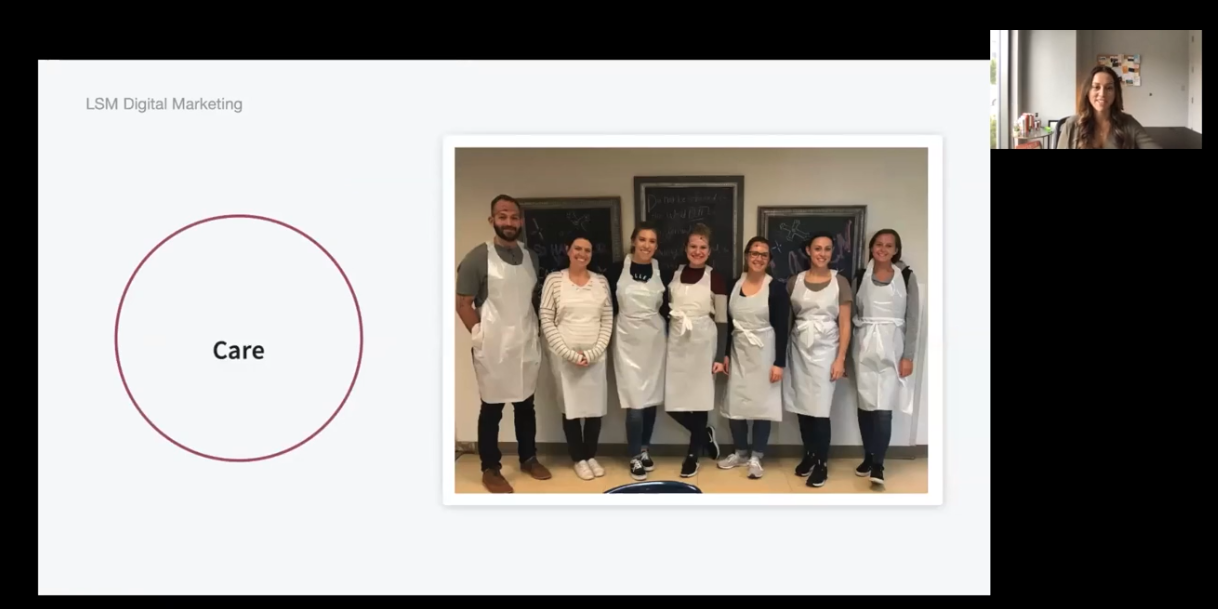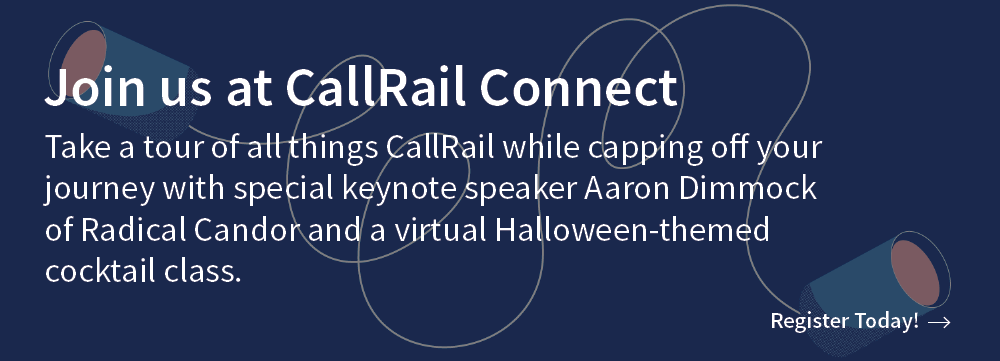Before COVID, the event team at CallRail would attend around ten conferences a year. As in-person events were canceled, figuring out how to stay top of mind with customers and how to generate leads was a top concern. Ultimately, the team had to pivot their entire event strategy.
Sound familiar?
Part of navigating the new normal means getting comfortable taking a different, and for some, a new approach. More specifically, adapting your in-person event strategy to fit the online world.
While virtual events are not new, the pandemic has accelerated its use. In fact, Eventbrite has seen a 2,000% year-over-year increase in online events in April 2020 compared to April 2019.
But dipping your toes into the virtual event world can be daunting. It can be hard to determine the best way to encourage people to sign up or what kind of content will have the most appeal.
The good news? We have your back. Here’s how to build a winning virtual event marketing strategy.
But first, what is a virtual event?
Some might hear the word virtual event and assume we mean a stand-alone webinar. However, at CallRail, there’s a distinction between the two.
For one, stand-alone webinars tend to be shorter in duration. Second, there’s usually only one topic and one speaker, and the goal is typically to generate leads.
Virtual events, on the other hand, are usually longer in duration. They can span from three to five hours.
Since they require more commitment from your audience, the leads generated from an online event tend to be more sales-ready than those from a stand-alone webinar.
Another point of differentiation we make is the format. Online events can be a virtual conference or a digital summit where there are multiple speakers, and participants can pick and choose which session they want to attend.
They can also be more interactive, like a virtual wine tasting session. Here are some examples of virtual events that can double up as inspiration:
Finally, a virtual event can have more than one goal. It can be used to drum up awareness for a new product or service and as a lead generation tool.
Why small businesses should invest in virtual events
Like their offline counterparts, virtual events are great for generating brand awareness and building up a roster of loyal brand advocates. But unlike in-person events, they don’t require nearly as many resources to get started.
The biggest benefit is the reduction in costs to get the event up and running. Because it’s digital, you no longer have to worry about booking a venue, finding vendors, renting equipment, etc.
Instead, you can focus on developing the content and sourcing the right speakers to drive registration. Additional benefits include:
Brand reach. Taking your event virtual allows you to access people you may not have been able to reach before. Anyone from anywhere can come across your event online and sign up.
Increase attendance. No longer restricted by a hotel or conference venue’s max capacity, you can invite as many people to your virtual event as you’d like. Just make sure your platform can support it.
Better to measure. Most video conferencing software collect the data for you. Through the dashboard, you can gain insights into how many people attended a particular session, at what point they dropped off and which sessions performed best.
A key component to consider when taking your events virtual
Virtual events are indeed more cost-effective, but the fundamentals of event planning still apply. You still need to have a solid promotional plan, content still needs to be relevant, and you still need to keep track of data to measure its success.
Yet, there are a few things to keep in mind when planning your virtual event. Because you can’t see attendees face to face, engagement is even more important. Zoom fatigue is real, and just because someone is on doesn’t necessarily mean they're engaged.
Between answering that last email or checking slack, attendees are facing a constant battle for their attention. Approaching your virtual event’s design from an engagement perspective first is the key to success.
Factoring engagement could be as easy as using breakout rooms at the start of your session to encourage participants to network. Likewise, you can use polls throughout a session or assign a fun assignment beforehand to pique attendees’ interest.
At CallRail, we like to do live Q&As where we ask participants to drop questions into the chat for speakers to answer after the session. However, we’re always looking for ways to improve, and this fall we are going to include a rum tasting event as part of the networking portion of our virtual event.
Building your virtual event marketing strategy
By now, you're ready to get started on your virtual event marketing strategy. Like a GPS, your strategy will provide you direction and clarity to get from point A to point B seamlessly. Here are the steps to build it out.
Step 1: Establish your goals
Like any marketing initiative, you first want to start by establishing the goal of your virtual event. This step serves as the blueprint for your strategy. By taking the time to map out your goals, you’re better able to define why you’re doing this virtual event while defining the tactics you’ll use in the process. Goals can include:
- Generating brand awareness
- Increasing sales
- Nurturing your target audience with educational content
- Accelerating the path from lead to loyal customer
- Lead generation
Step 2: Know your audience
Do you know the channels your audience prefers? The kind of content they like to consume? Their challenges and pain points?
Knowing your audience helps you better tailor the content of your virtual event to fit their needs. If you have buyer personas on hand, now is a great time to bring them out.
Not only will it help in planning your content, but it can also play a pivotal role in developing your promotional mix.
Step 3: Nail down your content
The next step is to develop the content. This is where you nail down your theme, speakers and topics.
Start by conducting research. You can do this by taking a peek at what your competitors are doing, seeing what your audience is reacting to on social media or you can survey your customer using a tool like SurveyMonkey.
Taking the time to understand what is out there gives you a better idea of the topics your audience cares most about. In doing so, you have more direction on how your content can contribute and add value to the conversation.
Another benefit of surveying your landscape is identifying opportunities to collaborate with other companies targeting the same audience. You can expand your reach via co-branding and partnership efforts—just make sure it’s not a competitor.
Step 4: Identify your promotional mix
From social media to video and direct mail, there are multiple ways you can market your virtual event. Check out this blog on tips for promoting and producing events for small businesses.
The key to identifying your promotional mix is selecting the channels your target audience lives on and then customize your messaging according to the channel and buyer persona profile.
A pro tip is to include a question on your survey when you’re looking for topics that ask your target audience how they prefer to get information. Then you can take that data and build your promotional strategy around those channels.
Step 5: Select the right platform
Do a quick G2 search for video conferencing software, and you’ll be bombarded with a plethora of options to choose from.
When it comes to selecting the right platform, it’s best to pick one that will help you best achieve your event goals and fits your budget. Common platforms you can tap into include Zoom, GoToMeeting, and ON24.
Step 6: Establish KPIs
The statement you can’t improve what you can’t measure is commonplace for a reason. If you don’t know how to measure your event’s success, how can you expect to know what worked and what didn’t?
Metrics like those associated with your promotional tactics are easy to track because they’re built into the software. Other tactics, like content marketing, can be harder to measure. However, including a UTM tag in Google Analytics takes care of that problem for you.
If you’re using CallRail, you can take it a step further. Through the form tracking tool, you can trace form submissions to your marketing efforts, providing you greater visibility into what’s working and what isn’t.
Other metrics we like to track to measure success include the number of registrations, number of actual attendees, and engaged attendance rates.
Gathering data throughout the virtual event lifecycle lets you know where to improve and optimize your process for future success.
Step 7: Follow up
Once an event is over, don’t forget to follow up with attendees. Sending recordings of the sessions and additional materials shared during the event is a great way to stay top of mind with participants.
Create follow-up campaigns by segmenting your registration list between those who showed up and those who didn’t. Sample messaging to those who attended can be a short thank you for attending and here’s a link to the event materials.
For those who were unable to make it sending them an email that tells them what they missed out can entice them to engage with your content and to reach out to learn more. And don’t forget to ask for feedback. This will help you refine your virtual event marketing strategies going forward.
Launching your virtual event
The idea of going live with your first virtual event can easily result in a bout of cold sweat. But we’re here to tell you that it’s okay.
Since the start of the pandemic, we’ve been making tweaks to our virtual event strategy — using every online event as an opportunity to learn and perfect our craft.
Before we moved our entire virtual event strategy virtual, we had, what we now call, a pilot event, that gave us a good idea of what to do going forward.
We planned a digital marketing boot camp in February to help our agency customers level up their marketing efforts. Since it was before COVID, we had the speakers come into our corporate office to film their sessions on Zoom.
The learnings from that first event became the blueprint for what we should and shouldn’t do when we had to move our in-person May event into a virtual one.
As you navigate the next step in going virtual with your events, we recommend starting small. From there, you can build on your findings.
If you want to see what a virtual event looks like an action, then we encourage you to sign up for our fall event.














